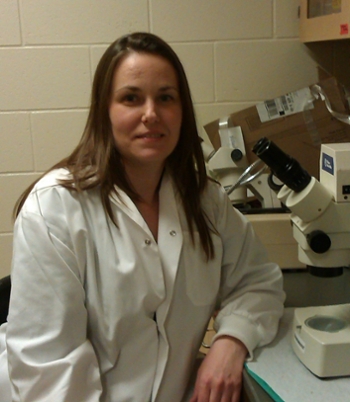
Research in our laboratory is focused on Hox genes and transcriptome analysis in the developing, adult, and aged mammalian central nervous system (CNS) to explore the genetic regulation of de novo myelination and remyelination. Myelin insulates the long processes extending from nerve cells (i.e. axons), protecting nerve cells and ensuring fast, efficient nerve impulses. Proper myelination of axons is critical for coordinated movement and cognitive functions (such as memory) although the efficiency of remyelination declines with age. This age-related impairment of remyelination is relevant to cognitive impairments accompanying several neurological disorders, including multiple sclerosis, Alzheimer's disease and dementia, and Parkinson's disease and Huntington’s disease. We are pursuing an integrated study of gene networks that influence myelin stability and repair in the aging brain. Our research lays the groundwork for developing therapeutic approaches to reverse CNS damage caused by several age-related neurodegenerative diseases.
A second important focus of our group is on the role of Hox genes in development, in particular investigating the genetic and epigenetic regulation of craniofacial development.
Research is funded by the Canadian Institutes of Health Research (CIHR), Natural Sciences and Engineering Research Council of Canada (NSERC), and the Multiple Sclerosis Society of Canada.
Neuroscience Research Cluster, GD10
University of Saskatchewan
Saskatoon, SK S7N 5E5

Dr. Adil Nazarali has been with the University of Saskatchewan since July 1995. He previously worked with Nobel Laureate, Dr. Marshall Nirenberg, at the National Institutes of Health (United States) cloning murine Hox genes. Dr. Nazarali teaches in the areas of Developmental Biology, Pharmaceutical Biotechnology and Toxicology.
Multiple Sclerosis (MS) Disease Modifying Therapy: A Reference Guide for Health Care Professionals
RECENT PUBLICATIONS
- Lorenz R, Grant E, Muyindike W, Maling S, Card C, Henry C, Nazarali AJ. Caregivers' Attitudes towards HIV Testing and Disclosure of HIV Status to At-Risk Children in Rural Uganda. PLoS One. 2016 Feb 16;11(2):e0148950. Link
- Hu Y, An Y, Fang N, Li Y, Jin H, Nazarali A, Ji S. The Optimization of Soluble PTEN Expression in Escherichia coli. Open Biochem J. 2015 Aug 21;9:42-8. Link
- Sadat SM, Saeidnia S, Nazarali AJ, Haddadi A. Nano-pharmaceutical formulations for targeted drug delivery against HER2 in breast cancer. Curr Cancer Drug Targets. 2015;15(1):71-86. Review.
- Carlson RJ, Doucette JR, Knox K, Nazarali AJ. Pharmacogenomics of interferon-β in multiple sclerosis: what has been accomplished and how can we ensure future progress? Cytokine Growth Factor Rev. 2015 Apr;26(2):249-61.
- Carlson RJ, Doucette JR, Nazarali AJ. Current developments in pharmacogenomics of multiple sclerosis. Cell Mol Neurobiol. 2014 Nov;34(8):1081-5.
- Smith TM, Lozanoff S, Iyyanar PP, Nazarali AJ. Molecular signaling along the anterior-posterior axis of early palate development. Front Physiol. 2013 Jan 7;3:488. Link
- Helal M, Das U, Bandy B, Islam A, Nazarali AJ, Dimmock JR. Mitochondrial dysfunction contributes to the cytotoxicity of some 3,5-bis(benzylidene)-4-piperidone derivatives in colon HCT-116 cells. Bioorg Med Chem Lett. 2013 Feb 15;23(4):1075-8.
- Wei Z, Gabriel GG, Rui L, Cao X, Pennington PR, Chlan-Fourney J, Nazarali AJ, Baker GB and Mousseau DD. Monoamine oxidase-A physically interacts with presenilin-1 (M146V) in the mouse cortex. J. Alzheimer's Disease 28: 403-422.
- Ji S, Doucette JR and Nazarali AJ, 2011. Sirt2 is a novel in vivo downstream target of Nkx2.2 and enhances oligodendroglial cell differentiation Journal of Molecular Cell Biology, 0: 1–9. Link
- Nazarali AJ, 2011. Marshall Nirenberg 1927-2010. Cellular and Molecular Neurobiology 6:805-807.
- Nazarali AJ and Talman WT, 2011. Special Issue on A Tribute to Marshall Nirenberg. Introduction. Cellular and Molecular Neurobiology, 6:803.
- Wang Y, Zhang Y, He J, Zhang H, Xiao L, Nazarali A, Zhang Z, Zhang D, Tan Q, Kong J and Li XM, 2011. Hyperforin promotes mitochondrial function and development of oligodendrocytes. Journal of Neurochemistry. Link
- Wang JM, Doucette JR and Nazarali AJ, 2011. Conditional Tet-regulated over-expression of Hoxa2 in CG4 cells increases their proliferation and delays their differentiation into oligodendrocyte-like cells expressing myelin basic protein, Cellular and Molecular Neurobiology, 6:875-886.
- Elsabahy M, Nazarali A and Foldvari M, 2011. Non-viral nucleic acid delivery: key challenges and future directions Current Drug Delivery 8: 235-244.
- Brown, GD and Nazarali, AJ, 2010. Matrix metalloproteinase-25 has a functional role in mouse secondary palate development and is a downstream target of TGF-b3. BMC Developmental Biology 10:93-101. Link HIGHLY ACCESSED
- Doucette, JR, Jiao R and Nazarali, 2010. Age-related and cuprizone-induced changes in myelin and transcription factor gene expression and in oligodendrocyte cell densities in the rostral corpus callosum of mice. Cellular and Molecular Neurobiology, 30:607-629.
- Zhang B, Wang X and Nazarali AJ, 2010. Ascorbic acid reverses valproic acid induced inhibition of Hoxa2 and maintains glutathione homeostasis in mouse embryos in culture. Cellular and Molecular Neurobiology, 30:137-148.
Dr. Kendra L. Furber, Research Associate
Kendra joined our lab in September 2013. She holds a BSc in Physiology and BA in Psychology from the University of Saskatchewan. Kendra completed a PhD in neuroscience at the Hotchkiss Brain Institute, University of Calgary investigating lipids and proteins involved in regulated cell secretion. Kendra currently holds an endMS Postdoctoral Fellowship from the Multiple Sclerosis Society of Canada. Her research focuses on cellular and molecular mechanisms underlying myelin degeneration during aging. This work will provide a better understanding of how to prevent myelin damage and promote its repair.
Dennis Okori Okello, Technician
Dennis joined our lab from Kampala, Uganda in September 2012 to pursue graduate studies in Pharmacy. He graduated with a Master's degree in Pharmacy from the University of Saskatchewan in October 2015. His thesis explored the expression profile of Six2 and its role in cell proliferation during early mouse secondary palate development. He has since continued to work in the lab as a technician. Dennis also holds a Bachelor of Pharmacy degree from Uganda.
|
|||||||||||||||||||||




